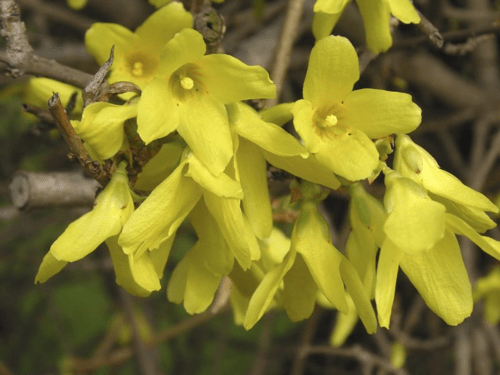Updated:February28,2024 Here at NHG, we know you love pretty blooms that are easy to plant,…
Winter-Blooming Shrubs II: Forsythia & Decidous Magnolia

Forsythia, a well-loved harbinger of spring, is a genus of deciduous shrubs in the Olive family (Oleaceae) native to eastern Asia. They typically grow to a height and width of three to nine feet, with yellow flowers that appear before the leaves, providing a striking show of winter blooms that compliment other winter-blooming shrubs. Two varieties at NHG now include:
Forsythia x intermedia ‘Lynwood’; a prolific bloomer in late winter and early spring. It is multi-branched with an upright growth habit of six to eight feet with a similar spread. It is a fast grower, and may require several prunings per year to maintain a desired appearance. In the fall the leaves turn green to yellow with a tinge of purple.
Forsythia x intermedia ‘Showy Border’ has large, bright yellow flowers that appear in March and April. It attains a height and width of four to seven feet and does well in full sun, tolerates difficult soil conditions, is deer resistant, and requires little maintenance. This beautiful spring bloomer would be effective in mass plantings or as border.
Needing a taller landscape accent? Deciduous magnolias are often called ‘tulip trees’ because the flowers are more upright and brightly colored. They tolerate wider temperature extremes than their evergreen relatives; however, the flowers appear before the leaves and may be damaged by late frosts. We have three deciduous magnolias to consider:
Magnolia x soulangiana ‘Alexandrina’ is a beautiful tree in the Magnolia family. It grows 20 to 30 feet in height. The tulip-shaped, showy, fragrant blooms are purple pink with white interiors. Bloom time is March to April. they require medium maintenance and tolerate clay soils, but do best in moist, slightly acidic soils. this tree has no serious insect or disease problems and is a beautiful specimen plant.
Magnolia x loebneri ‘Dr. Merrill’ is a vigorous-growing large shrub or small tree attaining a height and width of 15 x 10 feet. The flowers are star-like and have a light fragrance. The tree needs regular weekly waterings in extreme heat. It serves well as a border or specimen plant.
Magnolia x liliflora ‘Reflorescens,’ the Jane Magnolia, is a hardy plant that blooms in late spring. It has a more compact appearance and grows to 10 x 12 feet in height and width, but may be pruned to suit a smaller space. It has upright blooms that are reddish purple with pale pink centers. The flowers, cones and seeds are often used in craft projects as are the leaves which turn a copper yellow in the fall. Jane is one of the “little girl hybrids” developed by the US National Arboretum in the 1950’s. These hybrids bloom two to four weeks later that other hybrids to reduce the possibility of late spring frost damage.
Visit NHG soon and allow one of our Garden Advisors to help you select the best variety of beautiful winter-blooming shrubs to suit your landscape needs.

